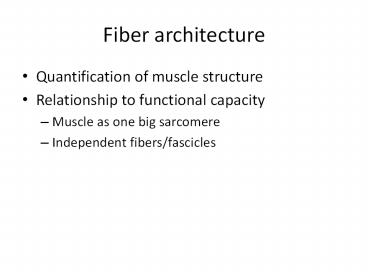Fiber architecture - PowerPoint PPT Presentation
1 / 31
Title:
Fiber architecture
Description:
Fiber architecture Quantification of muscle structure Relationship to functional capacity Muscle as one big sarcomere Independent fibers/fascicles – PowerPoint PPT presentation
Number of Views:167
Avg rating:3.0/5.0
Title: Fiber architecture
1
Fiber architecture
- Quantification of muscle structure
- Relationship to functional capacity
- Muscle as one big sarcomere
- Independent fibers/fascicles
2
Terminology
- Attachments
- Origin
- Insertion
- Muscle belly
- Aponeurosis (internal tendon)
- Fascicle (Perimysium)
- Compartment
- Pennation
3
Connective tissue layers
- Endomysium
- Perimysium
- Epimysium
Purslow Trotter 1994
4
Muscles are 3-D structures
5
Structural definition
- Qualitative
- Epimysium
- Discrete tendon
- Insertion (gastroc)
- Origin (extensor digiti longus)
- Easy to separate
- Electrophysiological
- Common nerve
- Common reflex
6
3-D structures
- Curved (centroid) paths
- Curved fiber paths
- Distributed attachments
- Varying fascicle length
7
Categorizing
- Pennation
- Longitudinal
- Unipennate
- Bipennate
- Multipennate
- Approximation
- Fascicle length
- Force capacity
8
Historical
- Stensen (1660)
- Borelli (1680)
- Gosch (1880)
9
Idealized muscles
- Muscle mass (M)
- Muscle length (Lm)
- Fascicle length (Lf)
- Pennation angle (q)
- Physiological cross sectional area (PCSA)
10
The Gans Bock Model
- Vastus Intermedius
- Identical facsicles
- Originate directly from bone
- Insert into tendon that lies parallel to bone
- Geometrical constraints
- Tendon moves parallel to bone
- Constant volume
- 2-D approximation
- No change into the paper
- ?Constant area
11
Force capacity
d
- Physiological cross-sectional area
- Sum fascicles perpendicular to axis
- Not measurable
- Fm Ts PCSA
- Prism approximation
- Volume bd
- B sin(q) V/Lf
- PCSA V/ Lf M/r/Lf
- Project force to tendon
- Ft Fm cos(q) TsM/r/Lf cos(q)
b
q
Fm
Lf
PCSA
Ft
12
Test PCSA
- Spector al., 1980
- Cat soleus and medial gastrocnemius
- Powell al., 1984
- Guinnea pig 8 calf muscles
Powell
Spector
130
41
Predicted PCSA (?)
Predicted Ft (o)
6
0.7
Relative measure
Measured force
13
Are pennate muscles strong?
- Ft TsM/r/Lf cos(q)
- cos(q) is always 1
- Ft Fm
- Fiber packing
- Series sarcomeres (A1, F1)
- Parallel sarcomeres (A6, F6)
- Pennate sarcomeres (A 6, F5.2)
14
Length change
d
- Fiber shortens from f?f1
- Rotates from q ? q1
- bd constant
- bfsin(q) bf1sin(q1)
- h fcos(q)-f1cos(q1)
- Fractional shortening in muscle isgreater than
the fractional shorteningof fascicles - If the fascicles rotate much
- eg 15 fibers, fascicle shorten 25?muscle 27
f1
b
h
q
q1
f
15
Operating range
- Muscle can shorten 50 (Weber, 1850)
- Operating range proportional to length
- Spasticity
- Reduced mobility (Crawford, 1954)
- Length-tension relationship
- Useful range stronglydependent on Lo
- Pennate fibers shortenless than their muscle
16
Velocity
- Force-velocity relationship
- Shortening muscle produces less force
- Power force speed
- Acceleration
- Architecture andbiochemistry influenceVmax
- Fiber type 2x
- Fiber length 12x
17
Other Geometries
- Point origin, point insertion
- Elastic aponeurosis
- Increase length with force
- Vm Va Vf
- Multipennate muscles
Cos(a-q) Cos(a)
Cos(q) Cos(a)
18
Other subdivisions
- Multiple bellies
- Digit flexors/extensors
- Biceps/Triceps
- Multiple discrete attachments
- Compartments
- Most large muscles
- Internal connective tissue
- Internal nerve branches
19
Multiple bellies
- Rat EDL
- 4 insertion tendons
- 2 nerve branches
- Glycogen depletion
- Discrete branch territories
- Mixing at ventral root
Balice-Gordon Thompson 1988
20
Compartments
- Cat lateral gastrocnemius
- Dense internal connective tissue
- Surface texture
- Internal nerve branches
21
LG Compartments
- Motor unit
- Axoninnervated fibers
- Constrained tocompartment
English Weeks, 1984
22
Neural view
- Does NS use the same divisions as anatomists?
- Careful training can control single motoneuron
- Behavioral recruitment spans muscles
- Mechanical tuning
- Training
23
Anatomical vs neural division
- Muscle
- Easily separated
- Separately innervated
- Multi-belly
- Partly separable
- Slight overlap of nerve territories
- Compartment
- Inseparable
- Slight overlap of nerve territories
24
Fibers and fascicles
- Rodents
- Fiber fascicle
- Easiest experimental model
- Small animals
- Fascicle 5-10 cm
- Fiber 1-2 cm (conduction velocity 2-5 m/s)
25
Motor unit distribution
Fibers innervated by single MN are near one MEP
band
- MU localized longitudinal
Motor endplates in sternomanibularis
Smits et al., 1994
Purslow Trotter, 1994
26
3-D reconstruction
- Relatively straight fibers
- Taper-in, taper-out
Ounjian et al., 1991
27
Mechanical independence
- Bag of spaghetti model
- Independent muscle/belly/compartment/fiber
- Little force sharing
- Fiber composite model
- Adjacent structures coupled elastically
- Lateral force transmission
28
Fiber level force transmission
- Sybil Street, 1983
- Frog sartorius
- All but one fiber removed from half muscle
- Anchor remaining fiber ends
- Anchor segment and clot
- Same force
29
Belly level force transmission
- Huijing al., 2002
- Rat EDL
- Separate digit tendons
- Cut one-by-one (TT)
- Pull bellies apart (MT)
- Little force change withtenotomy only
30
Muscle level force transmission
- Maas al., 2001
- Rat TA and EDL
- Separate controlof muscle lengths
- Measure both EDLorigininsert F
- 10 EDL-TA trans
31
Summary
- Architectural quantification M, Lm, Lf, q
- Estimates of force production PCSA (Fm), Ft
- Simple models are pretty good
- Sub-muscular structures compartments
- Neural structure is not the same as muscle
structure































